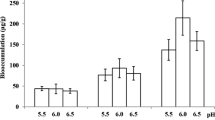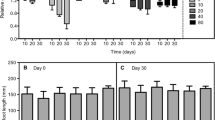Abstract
Laboratory experiments were designed to assess the relative importance of root vs shoot uptake of mercury by the submerged isoetid aquatic macrophyte Eriocaulon septangulare. Roots of mature plants that had been cultured for 31 days in sediments contaminated with non-toxic (approx. 1 μg g−1) concentrations of inorganic mercury had significantly higher concentrations and significantly greater mercury content than plants cultured in the same way but in sediments without added mercury. Under the same experimental conditions, mercury content of leaves was related to the concentration of mercury in the water, being greater in the treatments which had higher total mercury in the water. The mercury in water in the experiments originated from the sediment. There was no evidence for transport of mercury from root to shoot within the plant, although there was possibly some transport in the opposite direction. The design of the experiment avoided making two compartments with a physical separation between the water (leaf)/sediment (root) interface, but with this design it was not possible to determine with certainty whether or not “downward” transport of mercury occurred within the plant. The results with E. septangulare and mercury support the idea that aquatic macrophytes can be useful monitors of metals in sediments.
Similar content being viewed by others
References
Allen SE, Grimshaw, HM, Parkinson JA, Quarmby C (1974) Chemical analysis of ecological materials. Blackwell Scientific Publications, Wiley-Interscience, NY, 565 pp
Aulio K (1980) Accumulation of copper in fluvial sediments and yellow water lilies (Nuphar lutea) at varying distances from a metal processing plant. Bull Environ Contam Toxicol 25:713–717
Barko JW, Smart RM (1980) Mobilization of sediment phosphorus by submersed freshwater macrophytes. Freshwater Biol 10:229–238
Bristow JM, Whitcombe M (1971) The role of roots in the nutrition of aquatic vascular plants. Am J Bot 58:8–13
Campbell PGC, Lewis AG, Chapman PM, Crowder AA, Fletcher WK, Imber B, Luoma SN, Stokes PM, Winfrey M (1988) Biologically available metals in sediments. NRCC No27694, Ottawa, Canada, 298 pp
Campbell PGC, Tessier A, Bisson M, Bougie R (1985) Accumulation of copper and zinc in the yellow water lily, Nuphar variegatum: relationships to metal partitioning in the adjacent lake sediment. Can J Fish Aquat Sci 42:23–32
Carignan R, Kalff J (1980) Phosphorus sources for aquatic weeds: Water or sediments? Science 207:987–989
Coquery M (1990) The relationship between Hg, Pb, Cd, Cu, and Fe in Eriocaulon septangulare and certain chemical properties of sediment and water: A biomonitoring approach. MSc thesis, University of Toronto, Canada, 160 pp
DeMarte JA, Hartman RT (1974) Studies on absorption of 32P, 59Fe, and 45Ca by water-milfoil (Myriophyllum exalbescens Fernald). Ecology 55:188–194
Denny P (1980) Solute movement in submerged angiosperms. Biol Rev 55:65–92
Evans RD (1986) Sources of mercury contamination in the sediments of small headwater lakes in south-central Ontario. Arch Environ Contam Toxicol 15:505–512
Eriksson C, Mortimer DC (1975) Mercury uptake in rooted higher aquatic plants; laboratory studies. Verh Int Verein Limnol 19:2087–2093
Faraday WE, Churchill AC (1979) Uptake of cadmium by the eelgrass Zostera marina. Mar Biol 53:293–298
Feldman C (1973) The preservation of dilute mercury solutions. Proc Univ MO, Ann Conf Trace Subst Environ Health 7:395–400
Knowlton FM, Boyle TP, Jones JR (1983) Uptake of lead from aquatic sediment by submersed macrophytes and crayfish. Arch Environ Contam Toxicol 12:535–541
Kraus ML, Weis P, Crow JH (1986) The excretion of heavy metals by the salt marsh cord grass, Spartina alterniflora, and Spartina's role in mercury cycle. Mar Environ Res 20:307–316
Kudo A, Townsend RD, Miller DR (1977) Prediction of mercury distribution in river sediments. J Environ Eng Div ASCE 103(EE4):605–614
Langston WJ (1982) The distribution of mercury in British estuarine sediments and its availability to deposit-feeding bivalves. J Mar Biol Assoc UK 62:667–684
Larsen VJ, Schierup HH (1981) Macrophyte cycling of zinc, copper, lead, and cadmium in the littoral zone of a polluted and a nonpolluted lake. II. Seasonal changes in heavy metal content of above-ground biomass and decomposing leaves of Phragmites australis (Cav.) Trin Aquat Bot 11:211–230
Lyngby JE, Brix H, Schierup HH (1982) Absorption and translocation of zinc in eelgrass (Zostera marina L.). J Exp Biol Ecol 58:259–270
Lyngby JE, Brix H (1987) Monitoring of heavy metal contamination in the Limfjord, Denmark, using biological indicators and sediment. Sci Tot Environ 64:239–252
Maury R, Boudou A, Ribeyre F, Engrand P (1988) Experimental study of mercury transfer between artificially contaminated sediment (CH3HgCl) and macrophytes (Elodea densa). Aquat Toxicol 12:213–228
Mayes RA, McIntosh AW, Anderson VL (1977) Uptake of cadmium and lead by a rooted aquatic macrophyte (Elodea canadensis). Ecology 58:1176–1180
McIntosh AW, Shephard BK, Mayes RA, Atchison GJ, Nelson DW (1978) Some aspects of sediment distribution and macrophyte cycling of heavy metals in a contaminated lake. J Environ QUal 7:301–305
McRoy CP, Barsdate RJ (1970) Phosphate absorption in eelgrass. Limnol Oceanogr 15:6–13
Mortimer DC (1985) Freshwater aquatic macrophytes as heavy metal monitors. The Ottawa River experience. Environ Monitor Assess 5:311–323
OMOE (Ontario Ministry of the Environment) (1983) Handbook of analytical methods for environmental samples. OMOE publication, Toronto, Canada, 675 pp
Rahn WJ Jr (1973) The role of Spartina alterniflora in the transfer of mercury in a salt marsh environment. MSc Thesis, Georgia Institute of Technology, Atlanta, 61 pp
Ray SN, White WJ (1976) Selected aquatic plants as indicator species for heavy metal pollution. J Environ Sci Health A11(12):717–725
Ray SN, White WJ (1979) Equisetum arvense. An aquatic vascular plant as a biological monitor for heavy metal pollution. Chemosphere 3:125–128
Schierup HH, Larsen VJ (1981) Macrophyte cycling of zinc, copper, lead and cadmium in the littoral zone of a polluted and a nonpolluted lake. I. Availability, uptake and translocation of heavy metals in Phragmites australis (cav.) Trin Aquat Bot 11:197–210
Welsh RPH, Denny P (1976) Waterplants and the recycling of heavy metals in an English Lake. In: Hemphill DD (ed) Trace subst environ health. University of Missouri, Columbia, MO, Vol 10, pp 217–223
—, — (1979) The translocation of lead and copper in two submerged aquatic angiosperm species. J Exp Bot 30:339–345
—, — (1980) The uptake of lead and copper by submerged aquatic macrophytes in two English lakes. J Ecol 68:443–455
Wren CD, MacCrimmon HR, Loescher DR (1983) Examination of bioaccumulation and biomagnification of metals in a Precambrian shield lake. Water Air Soil Pollut 19:277–291.
Zar JH (1984) Biostatistical analysis. Prentice-Hall, Englewood Cliffs, NJ, 718 pp
Author information
Authors and Affiliations
Rights and permissions
About this article
Cite this article
Coquery, M., Welbourn, P.M. Mercury uptake from contaminated water and sediment by the rooted and submerged aquatic macrophyte Eriocaulon septangulare . Arch. Environ. Contam. Toxicol. 26, 335–341 (1994). https://doi.org/10.1007/BF00203560
Received:
Revised:
Issue Date:
DOI: https://doi.org/10.1007/BF00203560




